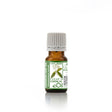Cinnamon Leaf Essential Oil Organic
Cinnamon Leaf Essential Oil Organic - 10 ML is backordered and will ship as soon as it is back in stock.
Description
Description
Cinnamon Leaf Essential Oil Organic (Cinnamomum zeylanicum) is steam distilled from fresh organic leaves, offering a warm, spicy aroma.
Renowned for its invigorating qualities, it is used in aromatherapy for uplifting blends, massage, and relaxation rituals.
100% pure, natural, and ideal for wellness routines
IDENTIFICATION
INCI name ; Cinnamomum Zeylanicum Leaf Oil
CAS number 8015-91-6
SKU code ; EN-CIL-0010
EXTRACTION METHOD ; Steam Distilled Essential Oil
PARTS USED ; Leaves
ORIGIN ; Madagascar
COMMON NAMES : Ceylon Cinnamon, True Cinnamon
APPEARANCE : Pale amber to reddish brown coloured liquid
ODOUR NOTE : Warm, spicy, woody, resinous characteristic aroma
QUALITY : 100 % pure and natural whole essential oil.
STORAGE CONDITION ; Store in a cool dark place
Cinnamon bark oil is indicated for usages related to colds and flu, and for topical massages related to digestions and stomach pains.
Cinnamon bark oil can be more irritating to the skin than Cinnamon leaf oil and must therefore, be even more diluted before a skin application than cinnamon leaf oil.
Cinnamon leaf oil holds more Eugenol and less Phenols than Cinnamon bark oil. Cinnamon leaf oil is more indicated for usages related to soothing muscular and joints aches and can be used in a diffuser.
This oil can cause severe irritation if used undiluted.
CINNAMON BARK VS CINNAMON LEAF
Cinnamon bark and cinnamon leaf essential oils are both derived from the Cinnamomum zeylanicum or Cinnamomum verum tree, but they differ in terms of the plant parts used for extraction, chemical composition, aroma, and applications in aromatherapy, perfumery, and skincare preparations.
Plant parts used for extraction: Cinnamon bark essential oil is extracted from the tree's bark, while cinnamon leaf essential oil is extracted from the leaves.
Chemical composition: Cinnamon bark essential oil contains higher concentrations of cinnamaldehyde, which gives it a warm, spicy, and sweet aroma. On the other hand, cinnamon leaf essential oil contains higher amounts of eugenol, giving it a milder, more herbal, and somewhat medicinal aroma.
Aroma: Cinnamon bark essential oil has a richer, warmer, and sweeter aroma compared to cinnamon leaf essential oil. The latter has a lighter, more herbal scent, which is less sweet and warm.
Aromatherapy: In aromatherapy, cinnamon bark essential oil is often used for its warming and uplifting properties. It may help to relieve stress, increase focus, and support emotional well-being. Cinnamon leaf essential oil, with its milder scent and different chemical composition, is considered to have more soothing and calming properties, making it useful for relaxation and stress relief.
Perfumery: Cinnamon bark essential oil is more widely used in perfumery due to its richer, sweeter, and more distinct aroma. It adds a warm, spicy note to fragrances and blends well with other essential oils like vanilla, clove, and orange. Cinnamon leaf essential oil is less commonly used in perfumery, as its aroma is milder and less distinctive.
Cinnamon leaf essential oil is milder and considered safer for use in skincare products. However, it should still be used with caution and in proper dilution, as it may cause skin irritation in some individuals. It can be used in skincare formulations for its antimicrobial, antifungal, and antioxidant properties.
In conclusion, cinnamon bark and cinnamon leaf essential oils offer different benefits in aromatherapy, perfumery, and skincare preparations.
While they share some properties, their distinct chemical compositions, aromas, and applications make them unique and valuable in their own right.
Always remember to use essential oils with caution, properly diluted, and according to the recommended guidelines.
INSTRUCTIONS OF USE
Massages & body care
- Targeted body massages: 1 drop in 10 ml C.O. or butter ++
Diffusion
- Ultrasonic Diffusers for air purification, use 10 mn 3 times a day. 6 to 12 drops in 100 ml water ++
Others
- Homecare. a few drops in base soap to disinfect surfaces.
For more detailed information, please go check this LINK TO Instructions of use essential oils page
DO NOT USE UNDILUTED and seek medical and specialist advise when in doubt
SEE OUR PAGE ON PRECAUTION - HOW TO USE ESSENTIAL OILS SAFELY
PROPERTIES
Reported benefits & properties:
- Rich in Eugenol
- Powerful polyvalent Antiseptic.
- Very Large spectrum Antibacterial.
- Fungicide, and anti-parasitic
- Antiviral and Immunity stimulant.
- Anti-inflammatory, anti-spasmodic
- Analgesic.
- Tonifying, stimulating.
- Stops fermentations processes.
- Warming effects
Traditionally used:
- To improve air quality, Bad smells (tobacco, cooking)
- To combat all kinds of infections (diffuser)
- To alleviate deep fatigues and somnolence (diffuser)
- To soothe aches, as a local anaesthetic (targeted massages)
USES
Traditionally used:
- To improve air quality, Bad smells (tobacco, cooking)
- To combat all kinds of infections (diffuser)
- To alleviate deep fatigues and somnolence (diffuser)
- To soothe aches, as a local anaesthetic (targeted massages)
BLEND WELL WITH
Bay Leaf Laurel, Bergamot, Black Pepper, Rock Rose Cistus, Clove Bud, Eucalyptus radiata, Frankincense, Ginger, , Lemon, Lemongrass, Myrrh, Nutmeg, Sweet Orange, Patchouli, Peppermint, Petitgrain, Sage, Tea Tree, Thyme, Vetiver, Wintergreen.
For air purification: sweet Orange, Lemon, Rosemary
For boosting circulation: pink grapefruit, Eucalyptus Citriodora, Rosemary verbenone,
For Targeted massages: ginger, ylang-ylang, Rosemary verbenone
SOME RECIPES | SYNERGIES
Please click on the link to access some synergies | recipes where you would use the Cinnamon leaf essential oil
CAUTION
Do not use during the first 3 months of pregnancy / breastfeeding
Keep out of reach of children and pets.
As a general rule, always perform a skin patch test before using your essential oils for the first time.
Due to the natural origin of our products, some ingredients may contain trace proteins or allergens, especially in unrefined oils.
We strongly recommend performing a patch test on a small skin area 48 hours before full use to check for sensitivities.
Always dilute essential oils appropriately and follow our recommended usage guidelines to ensure safe application.
If you experience any irritation or allergic reaction, discontinue use immediately and consult a healthcare professional
For more detailed information, please go check this LINK TO Instructions of use essential oils page
DO NOT USE UNDILUTED and SEEK MEDICAL AND SPECIALIST ADVISE WHEN IN DOUBT.
SEE OUR PAGE ON PRECAUTION - HOW TO USE ESSENTIAL OILS SAFELY



